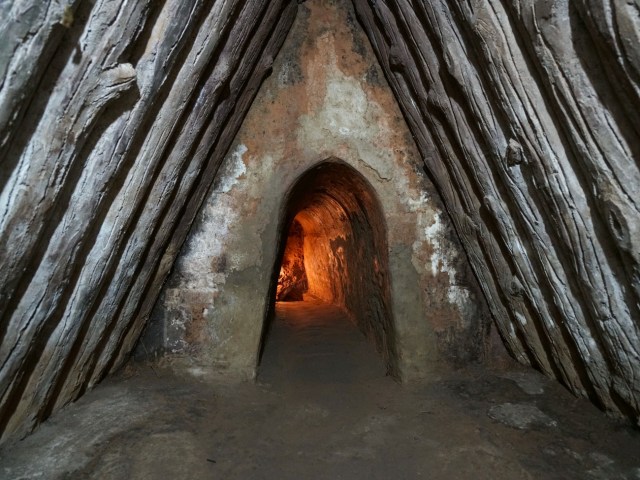In many travel destinations, what you see is what you get. Postcard-perfect attractions — such as the Eiffel Tower in Paris or the Colosseum in Rome — are easy to find and therefore uber-popular. But not every city’s most fascinating attractions are so obvious. In such places, there is much more than meets the eye, and to find it, you’ll have to go somewhere unexpected: underground. The thrill of discovering these hidden treasures, secret ruins, forgotten cities, and landmarks beneath modern-day towns is an adventure in itself. Here are seven cities with secret underground ruins to explore.
Seattle Underground – Seattle, Washington

After the Great Fire of 1889 devastated downtown Seattle, the city needed a major infrastructure overhaul. Faced with constant flooding on the mud flats of Puget Sound (where most businesses were located), the city rebuilt on top of itself, encapsulating the old storefronts and sidewalks beneath layers of brick, steel beams, and soil. Some businesses continued to use the now subterranean levels of their buildings, but most built on top of them.
By the early 20th century, most of these basements in the Pioneer Square neighborhood were abandoned. But as the decades passed, store owners and tour operators realized they had a compelling tourist attraction on their hands. Now, visitors can tour some areas of this mysterious underground city while walking alongside crumbling storefronts and 100-year-old artifacts, offering a glimpse into Seattle’s fascinating past.
Prohibition Tunnels – Moose Jaw, Canada

Situated along the Trans-Canada Highway in Saskatchewan, Moose Jaw harbors tales from early Chinese immigrants and legends of Al Capone’s Prohibition-era smuggling ring. These stories have one thing in common — they were rumored to use underground passageways beneath downtown. No one knows for sure who built the passageways, but one reasonable guess is that Chinese rail workers constructed them during the early 1900s. It is said that some workers lived underground for fear of their safety in the midst of racism. Others say that Al Capone enlisted his cronies to build the underground network to store and ship bootlegged liquor.
Today, there are two popular tours of the tunnels for tourists. One highlights the story of Chinese settlers; the other speculates on Al Capone’s illegal enterprise in the city. Although the tours aren’t always true to fact, the underground passageways are genuine and steeped in history and mystery, offering a glimpse into the unique heritage of Moose Jaw.
Lava Caves – Auckland, New Zealand

New Zealand is no stranger to volcanic eruptions. Over many millennia, these eruptions have created lava tubes, which are winding underground tunnels formed by oozing molten material following an eruption. Hundreds of tubes lie beneath Auckland, New Zealand’s largest city. More caves are discovered yearly — some in remote fields, others in private backyards — and archaeologists are working to map and preserve them.
Much to the surprise of early researchers, however, the caves weren’t empty. The Māori peoples began using them as burial sites for humans when they first settled in New Zealand in the 13th century. During World War II, members of the Communist Party occupied the caves and operated a covert printing press. While many of central Auckland’s caves are closed to the public for safety and conservation reasons, just outside the city are the Rangitoto Island lava caves, which are open for hikers to explore.
Wieliczka Salt Mine – Wieliczka, Poland

Salt has been mined in southern Poland since Neolithic times, and the first underground mine shaft at the Wieliczka Salt Mine was constructed sometime at the end of the 13th century. The lucrative salt mine not only made Poland’s king, Casimir III, very wealthy but also attracted people from around the region to see the impressive feat. The first documented tourist was famous astronomer and mathematician Nicolaus Copernicus in 1493; a statue of him lies along the Tourist Route in the mines today.
The mine expanded greatly between the 16th and 18th centuries, and curious scientists, diplomats, and ordinary travelers continued to visit. At the time, visitors needed a special royal permit to enter and participate in the mine’s activities, including underground train rides, boat tours, and orchestra performances. Nowadays, mining has ceased, but its subterranean remnants are open to all tourists. Chandeliers light the way as you descend into the depths of the mine while walking along saline lakes. There’s even an underground Polish eatery, along with the impressive St. Kinga’s Chapel.
Vietnam War Tunnels – Ho Chi Minh City, Vietnam

Just outside of Ho Chi Minh City in the district of Cu Chi are some of the best-preserved tunnels from the Vietnam War, which were once used by the Viet Cong to deter American and South Vietnamese forces. Thousands of miles of winding tunnels cross the region, dating to as early as the 1940s. Troops not only used the tunnels to set booby traps and transport supplies, but also lived in them during the height of the war.
Today, these passageways are a popular tourist attraction where guests can learn more about the war’s devastating impact on the region. Visitors can crawl through tunnels and see defunct command centers and booby traps. The Vietnamese government has preserved these tunnels to encourage visitors to explore and honor the lives lost in the war.
Secret Canals – Cape Town, South Africa

A few yards below the Castle of Good Hope and the cobbled streets of Cape Town are a series of canals once used for defense and irrigation. Dutch settlers created most of the canals as early as the 17th century to direct water from Table Mountain downhill and through the city to tend to gardens and transport supplies. The canals were sealed off in the mid-19th century for hygiene reasons, and the city was built over them. Today, visitors can walk the web of brick passageways underneath downtown Cape Town — at times wading through ankle-deep water — as guides explain the region’s colonial history.
Cisternerne – Frederiksberg, Denmark

A relaxing stroll through Søndermarken park outside of Copenhagen can turn into a real adventure — if you dare to head underground. Two glass pyramids stand in a grassy area of the park, but unknowing passersby would have no idea there is a subterranean world waiting to be discovered. Beyond the doors are the ruins of a 19th-century water reservoir that has been transformed into a modern event space.
Called Cisternerne, this massive cave once held drinking water for the residents of the Danish capital city. It was active from the mid-19th century to the mid-20th century but was drained in 1981. Today, the Frederiksberg Museums use the reservoir’s empty hull as a unique art exhibition and installation space, blending history and modern art for all to enjoy.
More from our network
Daily Passport is part of Inbox Studio, which publishes content that uplifts, informs, and inspires.






















